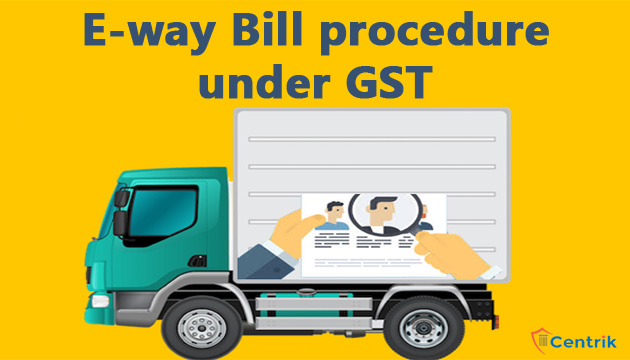
After notifying e-way bill vide notification no. 27/2017, CG is all set to turn out with e way bill rules on voluntarily basis from 16th Jan, 2018 and on compulsorily basis from 1st Feb, 2018.
24th GST Council meet held on 16th December 2017 released some points which says States have option to implement e-way bill system in their respective state anytime before 1st June, 2018. After that it will uniformly apply to all states.
What is E-way Bill?
E-way Bill is an electronic way bill giving details and instructions relating to the shipment of a consignment of goods. It will be an effective tool to track movement of goods and check tax evasion.
Who will generate E-way Bill?
- Where the transportation is being done in own/hired conveyance and value of goods is more than Rs. 50,000. E-way bill is to be generated by the consignor or consignee himself.
- Where the goods are handed over to a transporter for transportation by road. E-way bill is to be generated by the Transporter.
- Where neither the consignor nor consignee generates the e-way bill for consignment whose value exceeds Rs. 50000.It will be the obligation on the transporter to generate it.
- Where goods are sent by a principal located in one State to a job worker located in any other State, E-way bill shall be generated by the principal irrespective of value of consignment
- Where handicraft goods are transported from one state to another by a person who has been exempted from registrationE-way bill shall be generated by the person/transporter irrespective of value of consignment
How e-way bill generated?
An E-way bill i.e., Form GST EWB-01 contains two Parts
Part-A
Invoice details need to be filled here including reason of transportation and Transport Document Number
Part-B
Vehicle number need to be filled here.
Upon generation of the e-way bill on the common portal, a unique e-way bill number will be generated that will be same for supplier, recipient and the transporter.
Recipient shall communicate his acceptance or rejection of the details mentioned in Part A of Form GST EWB-01. In case, the recipient does not communicate his acceptance or rejection within 72 hours of the details being made available to him on the common portal, it shall be deemed that he has accepted the details filled therein.
Exception to E-way bill
No e-way bill is required to be generated in the following cases
a) Transport of goods as specified in Annexure to Rule 138 of the CGST Rules, 2017
b) Goods being transported by a non-motorised conveyance;
c) Goods being transported from the port, airport, air cargo complex and land customs station to an inland container depot or a container freight station for clearance by Customs;
d) In respect of movement of goods within such areas as are notified under rule 138(14) (d) of the SGST Rules, 2017 of the concerned states
e) Consignment value less than Rs. 50,000/-
Validity of E-way Bill
Validity of E-way bill depends upon the distance travelled. Up to 100km e-way bill will be valid for one day from the date on which e-way bill has been generated. Each day shall be counted as 24 hours.
For instances, if a conveyance will cover distance of 500 km, e-way bill will be valid for 5 days
Cancellation of E-way bill
An e-way bill may be cancelled electronically on the common portal within 24 hours of generation of the e-way bill. Further it has been provided that e-way bill cannot be cancelled if it has been verified in transit.
Results of Non-adhering to e-way bill
A registered taxable person who transports any taxable goods without the enclosing specified documents (e-way bill is one of the specified documents) shall be liable to a penalty of the amount
Rs.10, 000/-
Or
Tax sought to be evade
Whichever is greater?
Conclusion
Implementation of e-way bill will surely reduce the tax evasion but it does not guarantee higher revenue. More digital interface will simplify the transportation system in India that will also improve the logistic industry by reducing travel time and increasing distance travelled.
Note – Please note that the above article is for education purpose only. This is based on our interpretation of laws which may differ person to person. Readers are expected to verify the facts and laws.





 join For Updates
join For Updates
A comprehensive E Way Bill guide that will help people at almost all stages of E Way Bill generation. Helped me completely.
Nice work.